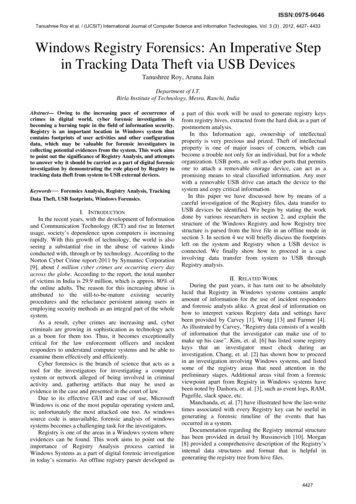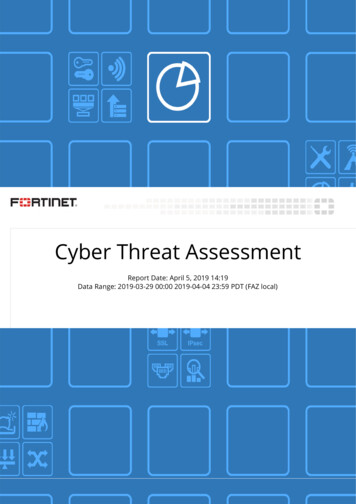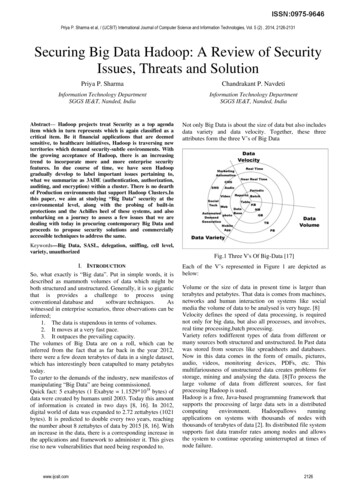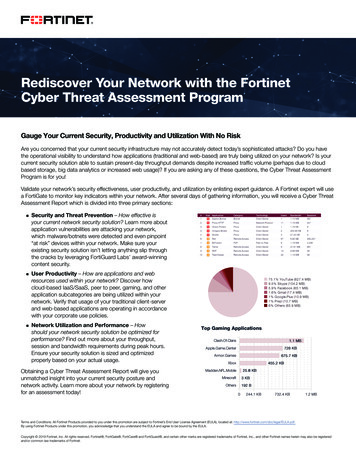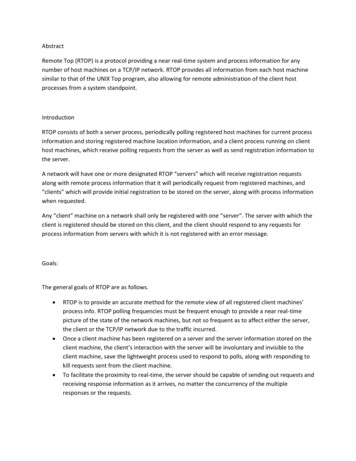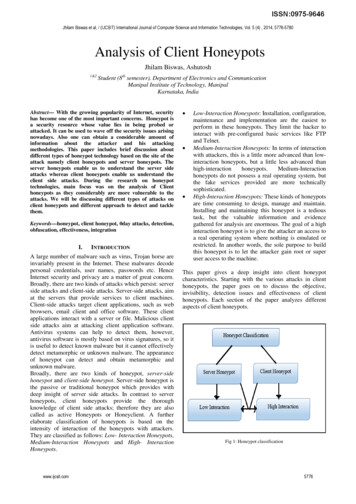
Transcription
Jhilam Biswas et al, / (IJCSIT) International Journal of Computer Science and Information Technologies, Vol. 5 (4) , 2014, 5776-5780Analysis of Client HoneypotsJhilam Biswas, Ashutosh1&2Student (8th semester), Department of Electronics and CommunicationManipal Institute of Technology, ManipalKarnataka, IndiaAbstract— With the growing popularity of Internet, securityhas become one of the most important concerns. Honeypot isa security resource whose value lies in being probed orattacked. It can be used to wave off the security issues arisingnowadays. Also one can obtain a considerable amount ofinformation about the attacker and his attackingmethodologies. This paper includes brief discussion aboutdifferent types of honeypot technology based on the site of theattack namely client honeypots and server honeypots. Theserver honeypots enable us to understand the server sideattacks whereas client honeypots enable us understand theclient side attacks. During the research on honeypottechnologies, main focus was on the analysis of Clienthoneypots as they considerably are more vulnerable to theattacks. We will be discussing different types of attacks onclient honeypots and different approach to detect and tacklethem.Keywords—honeypot, client honeypot, 0day attacks, detection,obfuscation, effectiveness, integrationI.INTRODUCTIONA large number of malware such as virus, Trojan horse areinvariably present in the Internet. These malwares decodepersonal credentials, user names, passwords etc. HenceInternet security and privacy are a matter of great concern.Broadly, there are two kinds of attacks which persist: serverside attacks and client-side attacks. Server-side attacks, aimat the servers that provide services to client machines.Client-side attacks target client applications, such as webbrowsers, email client and office software. These clientapplications interact with a server or file. Malicious clientside attacks aim at attacking client application software.Antivirus systems can help to detect them, however,antivirus software is mostly based on virus signatures, so itis useful to detect known malware but it cannot effectivelydetect metamorphic or unknown malware. The appearanceof honeypot can detect and obtain metamorphic andunknown malware.Broadly, there are two kinds of honeypot, server-sidehoneypot and client-side honeypot. Server-side honeypot isthe passive or traditional honeypot which provides withdeep insight of server side attacks. In contrast to serverhoneypots, client honeypots provide the thoroughknowledge of client side attacks; therefore they are alsocalled as active Honeypots or Honeyclient. A furtherelaborate classification of honeypots is based on theintensity of interaction of the honeypots with attackers.They are classified as follows: Low- Interaction Honeypots,Medium-Interaction Honeypots and High- InteractionHoneypots.www.ijcsit.com Low-Interaction Honeypots: Installation, configuration,maintenance and implementation are the easiest toperform in these honeypots. They limit the hacker tointeract with pre-configured basic services like FTPand Telnet.Medium-Interaction Honeypots: In terms of interactionwith attackers, this is a little more advanced than lowinteraction honeypots, but a little less advanced neypots do not possess a real operating system, butthe fake services provided are more technicallysophisticated.High-Interaction Honeypots: These kinds of honeypotsare time consuming to design, manage and maintain.Installing and maintaining this honeypot is a tedioustask, but the valuable information and evidencegathered for analysis are enormous. The goal of a highinteraction honeypot is to give the attacker an access toa real operating system where nothing is emulated orrestricted. In another words, the sole purpose to buildthis honeypot is to let the attacker gain root or superuser access to the machine.This paper gives a deep insight into client honeypotcharacteristics. Starting with the various attacks in clienthoneypots, the paper goes on to discuss the objective,invisibility, detection issues and effectiveness of clienthoneypots. Each section of the paper analyzes differentaspects of client honeypots.Fig 1: Honeypot classification5776
Jhilam Biswas et al, / (IJCSIT) International Journal of Computer Science and Information Technologies, Vol. 5 (4) , 2014, 5776-5780II.ATTACKS IN CLIENT HONEYPOTSOne of the major type of attack that have been facedrecently are client-side attacks. Client-side attacks are thosewhich are launched against client user. In this type of attack,an attacker makes use of client application’s vulnerabilitiesto take control of the client system by the malicious server.However, client side attacks are not limited only to the webbrowser vulnerabilities, but can occur on any client/serverpairs, for example e-mail, adobe, instant messaging,multimedia streaming, etc. In this section we will discusssome issues relating to client-side threats: drive-bydownload, code obfuscation, phishing, and exploit servers.A. Drive-by DownloadA drive-by download is an attack where malicious serverscan change the state of client machine without user’sconsent, which usually refers to the ability to download andinstall a program to client system without user’s consent.B. Code BecloudingAttackers usually want to hide the exploit vector by usingvarious encoding options to make the code vague and hardto understand. This technique aims for evading staticdetection tools such as IDSs, anti-virus tools, and firewallfilters. Attacker can use beclouding to make the exploit codeof JavaScript or VBscript unreadable during transportationfrom web server to client web browser. Attacker can usemultiple layers to encode the code which make the codeharder to be decoded.C. PhishingPhishing is an attack that combines between socialengineering techniques and sophisticated attack vectors toacquire sensitive information or data from end users.Phisher typically try to lure her victim into clicking a URLpointing to a rogue page which does not have real exploitcode; it just tries to deceive the client by entering credentialto log to a fake site. Phisher typically uses redirectionmethod to redirect the user to benign website.III.OBJECTIVE OF CLIENT HONEYPOTSThe prime motive of client honeypots is to identify anddetect malicious activities across the Internet. The mainfunctions of client honeypots are listed as follows: Client honeypot should enable real-time detectionof attacks. Client honeypots should be able to detect allknown and unknown threats against anyclient/server user application. Client honeypotshould be able to check various URLs (images,executable files, html, scripts) Researches of client-side honeypot most aim atfinding malicious website. Their data sourcecomes from search engine or blacklist. Dynamic modification of the detection andsecurity policy rules are the other features clienthoneypots should possess.The general approach of client honeypots has the followingtwo phases:www.ijcsit.comCrawling: In this phase, honeypot trace malicious websites.This phase is common for all client honeypots. Client-sidehoneypot needs data source. Crawlers are used to getURLs, which are later inspected in the honeypot. However,in general, the speed of crawler and the speed of thehoneypot don’t match. Normally, the crawler is faster thanthe behavior of opening processes in the honeypot. Thebehaviors in the honeypot are restricted by networkbandwidth and performance of operating system. Theprocess of open URL or file needs a certain amount of time.It is a bottleneck that affects system efficiency. As a result,two factors: the efficiency and coverage need considerationwhile designing a crawler.Detecting: In this phase, honeypot identifies whether thequeued sites are malicious or benign. Two approaches areused by client honeypots to detect malicious website:1) Pattern-Matching: It is used by low interaction clienthoneypots. Low interaction client honeypots do not usefully functional operating system or web browser, insteadthey use simulated client. Low interaction client honeypotsare often emulated web browsers, or web crawlers, whichdo have or only have limited abilities for attackers tointeract with. Low interaction client honeypots send HTTPrequests to the web server and detect malicious servers byapplying signature based or heuristic methods on the serverresponse for a fast analysis. They can directly detect thesecurity violation by applying static signature or heuristicsbased method on web server’s response. Thus, honeypotwhich use this method arequick in detecting attacks.However obfuscated attacks and other unimplementedattack types are likely to be missed by this detectionmethod.2) Inegrity Check (State Changes Check): It is used byhigh interaction client honeypots. High interaction clienthoneypot gives an attacker the oppurtunity to interact withreal system rather than simulation. State changes checkmechanism is a process that enables high interactionhoneypots to detect security violations. Various clienthoneypots use approaches such as HoneyClient,HoneyMonkey, and Capture through which users access thesuspicious sites of the presorted sites. Simultaneously,honeypot is monitored closely to detect occurance of anychanges happening on the client system. Any changeshould give first insight that the system has been affected.Monitoring the followings can provide an indicationwhether the system has been exploited: File system activities. Registry entries. Processes. Network connections. Memory. This is the ultimate state change check.However, such investigation is a tedious task. In order toachieve easier and faster implementation, current highinteraction client honeypots (HoneyClient, HoneyMonkey,Capture,) are limited to monitor file system, registryentries, and processes. While using the integrity checkmethod, more attention has to be given to avoid falsepositives. As an example, website may create cookies on5777
Jhilam Biswas et al, / (IJCSIT) International Journal of Computer Science and Information Technologies, Vol. 5 (4) , 2014, 5776-5780the system to save some information like IP addresses,number of user visits to the website, etc. Thus, there shouldbe some kind of exclude lists to prohibit false positives.Client honeypots operating in different networks can reportthe collected information findings to central sites that cancorrelate the data. The analysis synthesized enables theoperator to keep track of collected information. Clienthoneypot can be run in virtual machines as Vmware. This ishelpful to easily reset the machine to the clean state after acompromise on the system takes place.IV.INVISIBILITY OF CLIENT HONEYPOTSClient honeypots also show “invisibility” feature similar toserver honeypots. Invisibility of client honeypot meanspreventing malicious websites from detecting the HTTPrequest that is sent by client honeypot. There are variousissues relating to the invisibility in client honeypots. Theyare anti-crawling techniques, virtual environment detection,geo-location attacks, and IP blacklisting. All these issueswill be discussed briefly.A. Anti-Crawling TechniquesAutomated crawlers allow malicious servers to fingerprintclient honeypots. They normally send requests to resourceswhich are invisible to human user and hence malicious websites are able to detect crawlers. These websites then ceasetriggering. This problem is difficult to solve, thus thecrawler should be refined to behave as identical to abrowser as possible. Also, client honeypots would sendmany http requests to crawl websites. Anti-crawlers can beused to limit the amount of http request per IP. To mitigatethis problem, intelligent crawling is used instead ofcrawling the whole web site, by looking for suspicious filesas scripts and images.B. Virtual Environment DetectionUse of VMware which is a virtual machine is a good choicefor resetting the client honeypot after the system has beencompromised. However, presence of virtual machines canbe detected by attackers using several methods; a detectioncode can be incorporated in the exploit page to detect thevirtual environment, and hence the malicious site can stoptriggering the exploit, behave differently, block honeypotIP or do something else to keep hidden from detection.C. Geo-location AttacksSome attacks target users at specific geographical places.Attackers can find out the location of visitors, and thenattack visitors in certain country or location. This issue canbe handled by two approaches. First being implementationby allowing running honeypot across many differentnetworks. Second approach can be using TOR service torun client honeypots behind various proxies.D. IP BlacklistingAs malicious websites can detect presence of honeypots byvarious means, they can even block honeypot IP. It is notpossible to hide client honeypot behavior completely,nevertheless it becomes hard to tackle this countertechnique unless we operate honeypots using various ISPs.This will force the malicious site to block various ISPs,which deprives the attacker from a large percentage of hisvictims.www.ijcsit.comV.DETECTION ISSUESDetection accuracy can be expressed by the rate at whichfalse negatives and false positives occur. In the light ofdetection approaches discussed in the previous section,various detection problems have been discussed.A. Human Behavior SimulationThe ultimate aim of client honeypots is to achieve the samebehavior as humans which might not be possible due toabsence of full features. This problem is more visible whendialog boxes pop up. A user is left with typically twooptions; either to accept the request or to deny it. Thewebsite might react differently depending on the userselection. It can even introduce dialog boxes and ask theuser to fill out; the user then has to click the OK button toprove he/she is human and not a spam, and the web sitedrops a cookie to suppress the dialog box for future visits.In this case, user input is necessary to determine theserver’s response. Malicious website even can useCAPTCHA, which is a type of challenge-response test, tocounter client honeypot. Using such response tests allowthe malicious website to hide its malicious activity fromclient honeypot. At the same time, the end users will bedeceived into believing that such website is trying toprotect itself against a spam abuse.B. Delayed ExploitA delayed exploit is also an important issue that needs to beconsidered when implementing high interaction clienthoneypots. Sometimes, there may be a delay between initialinfection and complete compromise. Low interactionhoneypots will not be evaded by this delay, as they applydirectly pattern-matching algorithm on the server’sresponse.This delay might be due to any or all of these three possiblereasons: Downloading more malware: Generally, a webpage first successfully exploits vulnerability inclient application; then downloads a process toinstall more malware on the system. In such casethe download process consumes some time. In themeantime, client honeypot has already acceptedanother web page. Logic Bombs:Logic bombs are exploitscontained on a malicious web page in which theexploit triggers only after a given period of timeand hence they also delay the compromise. User-Triggered Exploits. This scenario ariseswhen the exploit needs a user action to trigger,such as mouse clicking. Correct pages are neededto be flagged so that user can get to know whichpage actually triggered and started thecompromise.C. Real-Time State Change CheckState changes checks can find out whether the web pagehas modified or changed something on client system. It canbe performed periodically but there will be some delay.Such checks are unreliable, since installed malware mayalso install rootkit which may further hide subsequentmalware instances, and thus make it hard to detect anychanges. Therefore, the integrity check should beperformed in real-time.5778
Jhilam Biswas et al, / (IJCSIT) International Journal of Computer Science and Information Technologies, Vol. 5 (4) , 2014, 5776-5780D. Attacks Against Internal Security PoliciesIn the present scenario high interaction client honeypotscannot detect exploits that do not make any persistent-statechanges .Thus, present high interaction client honeypotsmight neglect attacks that are targeted at violating theinternal security policies of the browser.E. 0day and Beclouding Attacks0day and beclouding attacks may not be detected by lowinteraction client honeypots. The reason being that thedetection algorithm used by low interaction clienthoneypots depend on implementing signatures for knownattacks. On the other hand, a high interaction clienthoneypots may detect these attacks if they try to make anychange on the system state.VI.EFFECTIVNESS OF CLIENT HONEYPOTSClient honeypot is sometimes also referred as computerhuman interaction tool. The effectiveness of clienthoneypots can be measured by the accuracy, reliability andcompleteness of the tasks a client honeypot performs.Broadly four factors are used to measure the effectivenessof a client honeypot. They are speed, detection, accuracyand invisibility. All the four factors are discussed briefly.A. SpeedSpeed of client honeypots can be expressed by number ofsites that can be connected and inspected in a given timeperiod. It has significance in describing the ability of theclient honeypot to identify malicious servers quickly and tosafeguard client user against them. The speed of clienthoneypots depends on various factors such as hardware,network connection, etc. It also depends on the clienthoneypot implementation which means more complex theimplementation, slower the honeypots are. Detectionalgorithms play an important role in speeding up thedetection process.B. Detection AccuracyClient honeypot should have high accuracy rate whiledetecting malicious servers. Detection accuracy can bemeasured by rate at which false positives (FPs) and falsenegatives (FNs) occur. With high interaction clienthoneypots, FP rate can be neglected; hence FN rate drivesthe accuracy of detection of malicious web pages. With lowinteraction client honeypots both FP and FN can beexpected to exist. Hence both FP and FN has to be takencare of while detection. The ability of client honeypots todetect malicious contents in website is influenced by boththe type of honeypot and also the operating environmentcharacteristics.C. InvisibilityThe value of honeypots depend on the amount of data thatit has gathered about the attacker after being probed. Unlikeserver honeypots, client honeypots do not use deception tolure malicious server to initiate attack. However, clienthoneypots should be kept undetectable by maliciouswebsites which can cease exploits trigger. Thus keeping theclient honeypots hidden allows it to gather more and moreinformation and eventually identifying more attackers.www.ijcsit.comFig 2: Effectiveness factors in client honeypotsVII. CLIENT HONEYPOT INTEGRATIONTill date, there is no compact client honeypot developmentthat integrates various detection mechanism andcapabilities of both low and high interaction honeypots thatare available in public. More so, no open source clienthoneypots are integrated with commercial tools like webbrowsers to provide real-time security for the end-user. It isa herculean task to deploy client honeypot that would allowbulk processing of URLs acquired from different sourceswith different confidence and priority levels. Clienthoneypots are a budding new technology used to secureclient-side system sturdily. Thus, they have to deal withlarge web space, various web technologies, evasiontechniques, various browser behavior and strong integrationwith operating system. However, client honeypots stillbeing a developing, immature technology, various tools arenot available and open for public research. Clienthoneypots need to operate as a service, rather than just aresearch tool to inspect some contents. Thus, there is a needfor elastic frameworks which allow easier integration withthe latest client honeypots, and enable to analyze thedetection of large space of attacks trends.VIII. DISCUSSIONIn this current generation of the Internet, a large number ofmalware exploit vulnerabilities in client applications. Thisis the main motivation of developing client honeypots.Lately, client honeypots have been greatly used in variousareas in network security. They can be used a useful tool toevaluate websites by examining websites contents whichhelps to identify malicious sites, applications, files, etc.They can be effectively used to evaluate and test client userapplications. Web browser being the most preferable targetfor attackers, researchers use client honeypots to test webbrowser security. To add to the list, client honeypots areable to identify and detect various client-side attacks.Integrity checks can be effective in discovering newthreats; this can be of great help to change the configurationand security policy to prevent such attacks. Lastly, clienthoneypots can help in mapping malicious neighborhoodsbecause malicious websites typically redirect to anothermalicious web sites [20].Implementation of client honeypot should depend on thegoals of honeypots and circumstances of operating.5779
Jhilam Biswas et al, / (IJCSIT) International Journal of Computer Science and Information Technologies, Vol. 5 (4) , 2014, 5776-5780Choosing honeypots specification are required to meetthese goals as they expose the full functional spectrum of acomputer system for the attacker to interact with andtherefore allow for collection of the desired data [7].Attacker uses various hiding and evading so that they arenot detected. Thus, developing efficient protectionmechanisms against malicious websites attacks requireseffective analysis tools which allow studying currentattacks and foreseen future attacks. For instance, manymalicious sites attack a client side only once in a giventimeframe, then all subsequent requests are redirected toharmless sites such as search engines. This aims to holddown the analysis and keep hidden from further tracking.Therefore, an analysis tool should have the ability to recordand reply all requests and responses involved in a detectedattack. Till now, open source client honeypot systems havenot leveraged the benefits of using both low and highinteraction solutions together. With combining lowinteraction honeypot and high interaction honeypot, ascalable architecture can be achieved at constant levels offalse negatives. Low interaction components can be used tosearch quickly for potential malicious sites, tag them assuspicious and only then hand them over to the highinteraction component for detailed analysis. To check if thelow interaction component is missing some attacks, a smallpercentage of URLs can be passed over to the highinteraction component and the results from bothcomponents are compared.[7], [11].Theoretically, highinteraction components can be used to extract signatures ofthreats, which can then be used in low interactioncomponents.IX.CONCLUSIONSClient honeypot is a new technology that aims to overcomethe weakness of server honeypots and other security toolsin dealing with client side attacks. Client honeypots use twoapproaches to detect client-side attacks: pattern matchingand integrity check. Each approach has benefits andshortcomings.There are several detection issues with the case of clienthoneypots which are needed to be addressed. Nevertheless,some implementations need to be thought of with regard toclient honeypots so as to increase its effectiveness be it interms speed or detection accuracy or both. Invisibility isalso a big issue regarding client honeypots which needs tobe dealt with. Current client honeypots are still in thedeveloping phase. They have various shortcomings relatingto their inability to detect and evade various attacks bymalicious attackers. In this paper, we introduced factors tomeasure the effectiveness of client honeypots: speed,detection accuracy and invisibility.This is a review paper that gives an overview on clienthoneypots. It talks in depth about various aspects of clienthoneypots like attacks, objective, invisibility, detection andeffectiveness of client honeypots. The concept of honeypotsbeing a new technology, they come in to help in three waysthat is prevention, detection and how users react to anattack. Not only do client honeypots become cost-effectiveto deploy and maintain, but they also have a betterintegration into the organization network. This paper can bewww.ijcsit.comof immense help to the novice as well as the experienced inthe field of network security with the help of clienthoneypots.ACKNOWLEDGEMENTSincere thanks to the professors of the Department ofElectronics and Communication and the department ofInformation and Communication Technology for providingexcellent laboratory facilities to carry out the research studyand gather valuable knowledge on ][11][12][13][14][15][16][17][18]Ren Liu. China virus status & Internet Security Report 02/eda7daf7970448608b2881d97c9a1868.shtm.VMware n efficient approach tocollect malware. In Proceedings of 9thSymposium on Recent Advances in Intrusion Detection (RAID’06),2006.Paul Baecher, Markus Koetter, Thorsten Holz, MaximillianDornseif, and Felix C. Freiling. The nepenthes platform: An efficientapproach to collect malware. In Proceedings of 9th Symposium onRecent Advances in Intrusion Detection (RAID’06), 2006.Jan Goebel, Thorsten Holz, and Carsten Willems. Measurement andAnalysis of Autonomous Spreading Malware in a UniversityEnvironment. In Proceeding of 4th Conference on Detection ofIntrusions & Malware, and Vulnerability Assessment (DIMVA’07),2007.Moheeb Abu Rajab, Jay Zarfoss, Fabian Monrose, and AndreasTerzis. A multifaceted approach to understanding the botnetphenomenon. In Proceedings of the 6th ACM SIGCOMMConference on Internet Measurement, ACM Press, New York, NY,USA, 2006, pp. 41–52J. Zhuge, T. Holz, X. Han, C. Song, and W. Zou. Collectingautonomous spreading malware using high-interaction honeypots. InProceedings of ICICS’07, 2007.Roger A. Grimes.Tracking malware with honeyclients. /77378 16OPsecadvise1.html.Kathy Wang.Using Honeyclient to Detect New Attacks. InProceedings of RECON 2005, Crowne Plaza Montreal, Canada,2005.Y.M. Wang, D. Beck, X. Jiang, R. Roussev, C. Verbowski,S. Chen,and S. T. King. Automated web patrol with strider honeymonkeys:Finding web sites that exploit browser vulnerabilities. In Proceedingsof 13th Network and Distributed System Security Symposium(NDSS’06), nts/686slides itePapers/WSLabsOverview.pdf.The Honeynet Project. Know Your Enemy: Malicious Web Servers,August 2007. http://www.honeynet.org/papers/C. Clementson,” Client-Side Threats and a Honeyclient-BasedDefense Mechanism, Honeyscout”, Master’s Thesis, LinköpingUniversity Electronic Press, 2009.C. Seifert, “Know Your Enemy: Behind the Scenes of ://www.honeynet.org/papers/wekC. Seifert, Improving Detection Speed and Accuracy with HybridClient Honeypots, Victoria University of Wellington, PhD Thesis,2008.C. Seifert, R. Steenson, T. Holz, Y. Bing, and M. A. Davis, “Knowyour enemy: Malicious web servers.” The /mws/M. Pennock, S. Lawrence, and L. C. Giles, “Methods for SamplingPages Uniformly from the World Wide Web”,In AAAIFallSymposium on Using Uncertainty within Computation(NorthFalmouth 2001), pp 121–128.5780
high interaction client honeypots. High interaction client honeypot gives an attacker the oppurtunity to interact with real system rather than simulation. State changes check mechanism is a process that enables high interaction honeypots to detect security violations. Various client honeypots use approaches such as HoneyClient,
